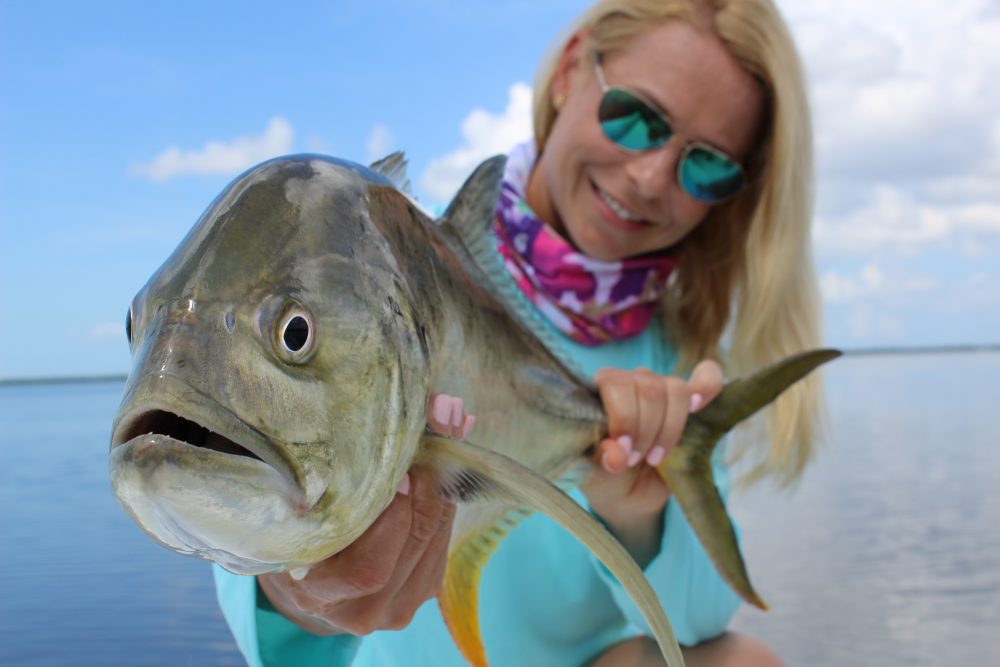Fishing resources and tips for the empowered female angler.
How To Catch Jumbo Jack Crevalle
September 13, 2016

While many anglers snub the jack crevalle, considering the species as just another undesirable component in a saltwater trash can slam, you may want to experience the unwavering strength and stamina first-hand before you make any judgment of your own. If you learn how to land a jumbo jack crevalle that’s 10-pounds or more, your fish fighting prowess will certainly be put to the test — just be ready for a fish that will hit your bait like a silvery freight-train on a direct route to some cavernous underwater depot.
Finding Big Jack Crevalle
While jumbo jack crevalle will go inshore to chase prey, they are more frequently found hanging out close to nearshore structure. Check nearshore natural and artificial reefs, rock piles, wrecks and ledges. You’re bound to spot a school of big jacks in these areas if your timing is right. Keep your eyes glued to the surface because a school of jack crevalle will make their presence known by creating a flurry of commotion as they feed.
If you are fishing inshore, you can still earn the opportunity to land a jumbo jack. Focus your inshore efforts on canals, creeks and rivers. Jacks like to linger around the mouths of these types of areas, so it’s not a bad idea to stop at these types of spots on your way back (or on your way out to) from areas of nearshore structure.
Wondering where and when to target big jack crevalle in the state of Florida? Some of the top spots in the Sunshine State include Tampa Bay during the late spring/early summer, the Florida Panhandle bays in late summer/fall, and from Palm Beach to Cape Canaveral on the East Coast during late winter/spring.
Best Baits For Jack Crevalle
These voracious feeders aren’t too picky, so they are the prime candidates for testing out different techniques and baits. You can use anything from natural baits to flies and should experience plenty of excitement if you keep at it. While jacks don’t make for good table fare, they sure compensate for that by being ever so obliging when other saltwater species are acting persnickety.
Natural Baits
Jack crevalle will feed on most type of baitfish (scaled sardine, threadfin herring or finger mullet). You can hook the baitfish through the back, in front of the dorsal fin, or through the nares (nostrils) — jacks aren’t really that particular. When using natural or live baits, use medium to medium heavy spinning gear with 12 to 14-pound test line, two to three feet of 30-pound fluorocarbon leader, and a 3/0 circle hook rigged underneath a popping cork or freelined. Most importantly, before you toss your bait into the water, don’t forget to test your drag. Leaving your drag too loose can easily cause a jumbo jack to spool you in a jiffy.
Artificial Baits
As you might imagine, the best lures to use for jack crevalle are baitfish-imitating lures. Try artificials such as the Yo-Zuri Crystal Minnow or Yo-Zuri 3D Popper. If you are a fan of topwater fishing, try “walk the dog” lures like Yo-Zuri’s 3DB Pencil (try the bone color) or Heddon Zara Spook and plan to go out early. Dawn and dusk will provide your best opportunity for an explosive topwater jack bite.
Fly Fishing
Use an 8 to 10 weight fly rod with a floating or intermediate line (either will work) and 16 to 20-pound bite tippet. Yes, jack crevalle do have teeth. As far as the type of fly to use, Clousers, Deceivers and Seaducers will all elicit strikes if they are consistently stripped at a rapid pace. Also, don’t forget to check to be sure you have plenty of backing on your reel.
Now that you know where to find big jacks and what type of tackle you’ll need to land one, read about the fish fighting mistakes you shouldn’t be making so that you’re prepared when a monster jack hits your bait!